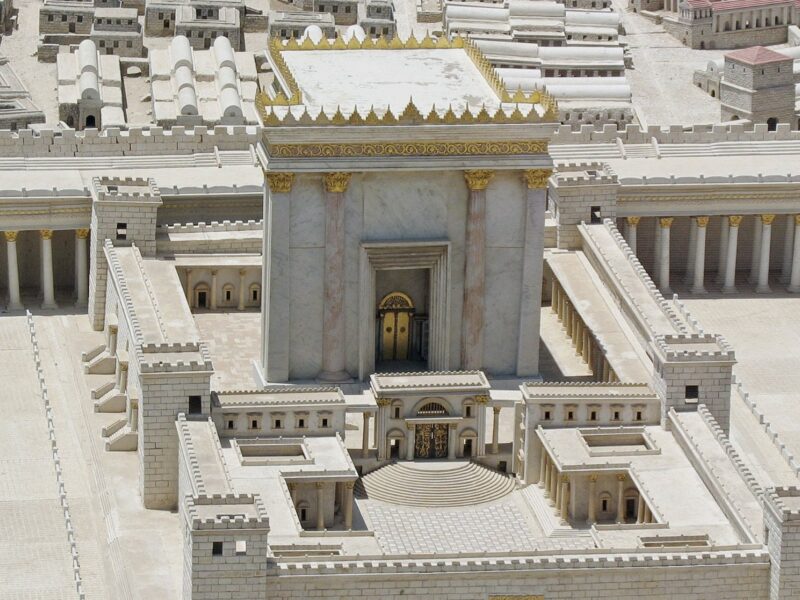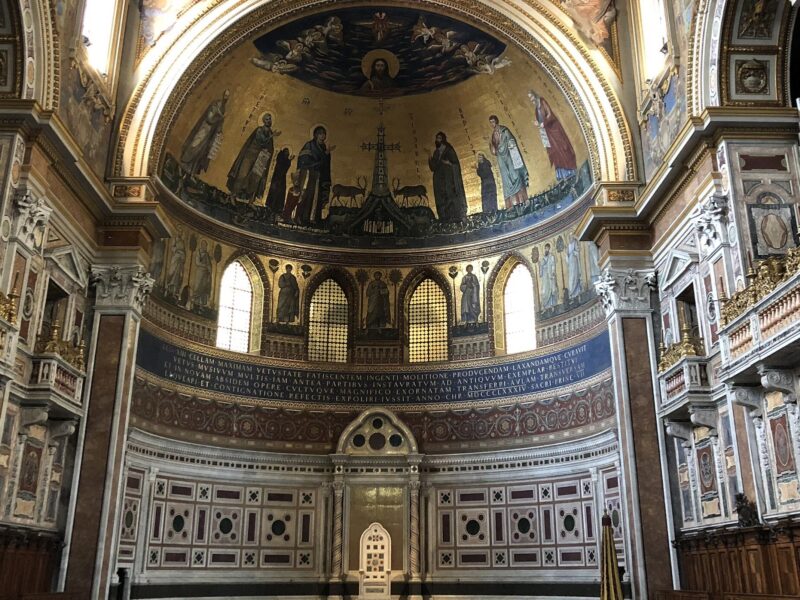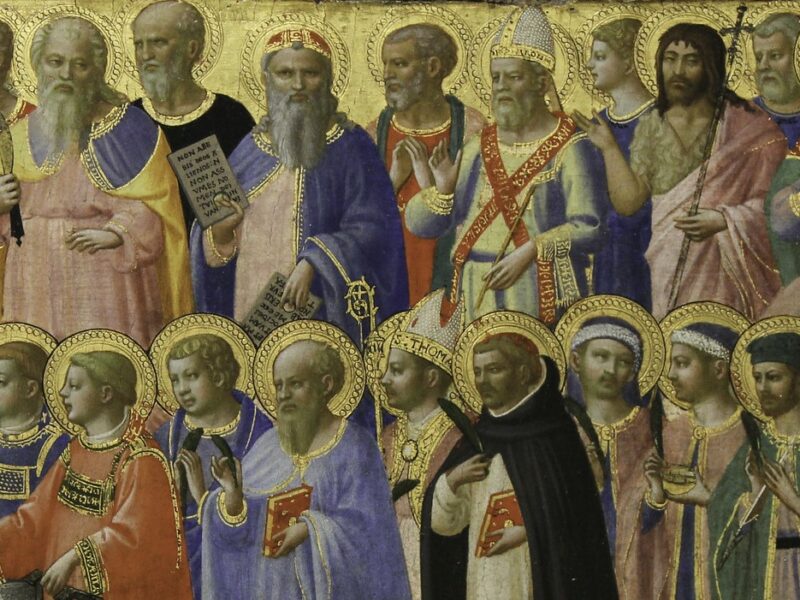
The End of the Harvest
Pentecost Sunday. Fr Allan White suggests that the timing of Pentecost shows us the nature of the challenge the Church always faces.
The days from Easter to Pentecost are known as the days of Easter. It is all one feast. The passion, death and resurrection of Christ is one triumphant action. It is a building feast, the building of the city of God; the heavenly Jerusalem adorned as though a bride for her husband. The end of the journey is the pentecostal city; that city in which we now live.
The Christian communion at prayer is Mount Zion. It is just that city that we read about in the Book of Revelation as it comes down out of heaven from God, prepared as a bride adorned for her husband.
Originally, Pentecost was a feast covering the 50 days of the harvest. It was a free-floating festival not tied to a definite date; it was a celebration of process. On the harvest Sabbath the sheaves were presented in the Temple and on the fiftieth day the first fruits were offered in joyful thanksgiving to God. The first and last days were linked.
Another school in Judaism linked the days of Pentecost with the feast of Passover, the liberation of the people from slavery in Egypt. The forty nine days preparation for the fiftieth day represented the time between Moses leading the people out of Egypt and their assembly at the foot of the mountain to receive the Law. What was begun in the Exodus was brought to fruition at Sinai.
So, Pentecost was not just an agricultural festival, it was a historical festival with a precise date and context. It was a feast of the giving of the Law when God married himself to Israel his bride.
St Luke shows us in his account of Pentecost that he knew all about this debate. He tells us that they were all together in one place. He does not say who they were. They were in a house. Tradition places this house on Mount Zion in Jerusalem, the temple mount. Mount Zion to every pious Jew is the true pole of the earth, the place where God dwells among men. But in the paschal events we celebrate a seismic shift takes place. The dwelling of God is not to be on Mount Zion, the new community of his body is to be the place where he makes his dwelling.
Luke is telling us then that the sealing of this new covenant both fulfils and transcends the covenant forged with Israel through Moses on the other mountain, the mountain of Sinai.
On Pentecost day the Church was gathered early in the morning, just like the morning on which Moses brought the people out of the camp to meet God. As they stood at the foot of the mountain, having prayed and fasted for a period beforehand, it was shaken by a great noise that sounded like thunder or a great trumpet blast, it was lit up by the fire of lightning as God disclosed his presence on the holy mountain. The spectacle was so great, so a first century rabbinical tradition tells us, that the peoples round about rushed to find out what was taking place, but they could not understand, being non-Jews and not having shared in the vision.
The fire and noise of the descent of the Holy Spirit also drew the curiosity and fear of the people of Jerusalem, the multitude of devout men, those pilgrims drawn from the Jewish communities of the diaspora were amazed and wondered and heard the preaching of the Gospel in their own tongues. Some understood but others could not so they gave it their own meaning: the disciples were merely drunk, even though it is between eight and nine in the morning.
The people of Israel at Sinai were one in mind and heart as they welcomed the Law as the gift of God, just like the Pentecost community in Jerusalem. Pentecost then is the epiphany, the manifestation of the covenant community of the Church which is born from the side of Christ on Calvary. The assembly of the people of Israel at the foot of Sinai was given a special name: it was called the ekklesia, which comes into English as Church, that assembly which is drawn into existence by the splendour of God’s word and sustained in existence by inspired obedience to it.
St Luke only uses this word in the Acts and never in his Gospel. For him the Church is brought into existence as it is addressed by the Risen Christ and drawn into obedience by the Spirit of Pentecost. God’s ten words, or commandments, at Sinai were meant to undo that sin of Adam; they were an attempt to reconstitute humanity in Adam’s shape. The Paschal events actually accomplish that, what the first Adam lost the second Adam not only wonderfully restores but raises to a new level of existence.
The first Covenant on Sinai presented a radical challenge to a world founded on injustice, competition and rivalry, and greed, it called the people of Israel to shape their lives to a new imperative, a way of life that incarnated new social, economic and cultural values that held together a redeemed community no longer bound in a world severed from God. The fulfilment of the New and Eternal Covenant, the Covenant sealed in the blood of Christ is God’s last word. It draws all who share in it into a new form of life, a life which is not narrowly tied to the present, nor confined in an oppressive nostalgia for the past, but which receives God’s future as a gift. This gift brings reconciliation, a reconciliation in which diversity and plurality are not expressed in an egotistical individualism, but in the charity and harmony of communion.
So, the Pentecost feast is both process and event. It celebrates the harvest which Christ has sown and the Spirit reaps. It celebrates that in the first fruits of the new humanity found in the risen Christ we too are present in the unity of the Holy Spirit before the throne of God.
But we still experience the tension of the already and the not-yet. The charm of the pilgrimage sometimes gives way to the strain of the route march. The Jerusalem community was a communion which, under the inspiration of the Spirit, renounced injustice, rivalry and greed and which had been freed from self-enclosure and self-preoccupation in order to be plunged into communion.
Some people see religion as an escape from life; some religions stress the importance of rising above humanity and the pressures of life to peace in a timeless world where earthly things do not matter. This is not Christianity: we started in the peace of an upper room, but the Holy Spirit found us out and forced us out into the street where the apostles caused a sensation. The life of the Church is to be a sign of God’s love for the world: even the unsavoury parts of human existence that we would prefer to forget about. Jesus spent his time healing the sick, associating with sinners and outcasts; he brought those who lived in the shadows out into the light.
There are those who would prefer to confine the Church to the Upper Room; the prospect of Christ in his Church clothed in his promises roaming the streets challenging the accepted bounds of human society is a threat. But since Pentecost that is no longer an option for us: we are out of seclusion and ready to gather the harvest which the Lord has sown.


